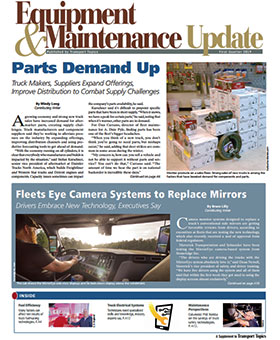Diesel Engine, Drivetrain Spec’ing Prove Crucial
Careful attention to diesel engine and drivetrain spec’ing is essential to ensure that Class 8 trucks have the highest productivity and lowest cost per mile for their specific applications.
Today, most vertically integrated truck manufacturers offer 13-liter engines and 12-speed automated transmissions.

Baxter
Despite the growth in popularity of 13-liter powerplants, Cummins and Detroit continue to offer 15-liter engines. These deliver surprising fuel economy because the larger cylinders can recover more energy, and often increase resale value, experts said. Meanwhile, 11-liter engines can further reduce vehicle weight but won’t perform as well with maximum weight at highway speeds, especially with downsped powertrains.
John Moore, product marketing manager for Volvo Trucks, said that trucks are cruising at higher speeds since the federal electronic logging device mandate took effect about a year ago. Volvo’s D13 engine performs better at speeds in excess of 65 mph than its D11, he said. The D13TC with turbo compounding is the most efficient under such conditions, Moore said. The engine’s turbo-compounding system recovers energy that is otherwise unavailable and allows an ultra-low rpm cruise of 1,060 rpm at 65 mph. Volvo claims 7.5% fuel savings.
There’s no “one-size-fits-all approach” to engine choice, and there are overlaps on which engine will provide the best performance, said Brian Daniels, manager of Detroit powertrain and component products. “Used primarily in longhaul sleeper applications, the Detroit DD15 is our most fuel-efficient engine as well as the most popular one,” Daniels said, adding that Detroit offers a 13-liter engine.

Tim Proctor, technical leader for heavy-duty products at Cummins, said the X15 Efficiency Series allows more room for expansion of the burning gases during the power stroke to recover more of the energy in the fuel. “Especially in linehaul service running 120,000 miles a year, 15-liter engines offer an advantage in performance, including in engine braking,” added Brett Merritt, vice president of Cummins’ on-highway engine business.
Peterbilt and Kenworth, both brands of Paccar, offer Cummins engines, and the Paccar MX 13 and MX 11. Jason Johnson, Paccar’s director of aftermarket, said these engines offer peak torque down to 900 rpm, though the higher ratings only provide it down to 1,000 rpm to protect the drivetrain.
Jim Nachtman, Navistar’s product manager for on-highway trucks, said the 12.4-liter A26 was specified in 12% of International’s LT Series trucks in 2017, and that percentage grew to 20% in 2018. The engine offers weight savings of 600 pounds versus a 15-liter engine.
Specifiers also must research the diesel drivetrain. The critical issue is direct drive versus overdrive in top gear, especially with downspeeding.
An incorrect ratio for a given application can reduce durability of the powertrain, said Dawn Clegg, director of product line management for rear axles in North America for Meritor. “For example, a direct-drive transmission with a super-fast ratio specified in a city delivery application will result in torque levels well beyond the design life of the components and could result in decreased life,” Clegg said.
Steve Slesinski, global director of product planning for the commercial vehicle market at Dana Inc., cited a shift from higher numeric axle ratios to lower ratios to keep an engine operating as efficiently as possible for most of the duty cycle. “But, moving to faster [lower numeric] ratios does not necessarily mean a move to direct-drive transmissions.”
Then, there’s overdrive effic- iency. Alex Stucky, product strategy manager with Eaton Cummins Automated Transmission Technologies, said the company’s Endurant transmission has twin countershafts designed to cancel out forces that otherwise would create end thrust that the bearings would have to handle, thus reducing friction. This means the truck can run in overdrive with less loss in the gears than in the past. Single countershaft makers, however, say that their products have fewer gear meshes, minimizing friction.
Direct drive is better with a cruise speed below 65 mph, Volvo’s Moore said.




